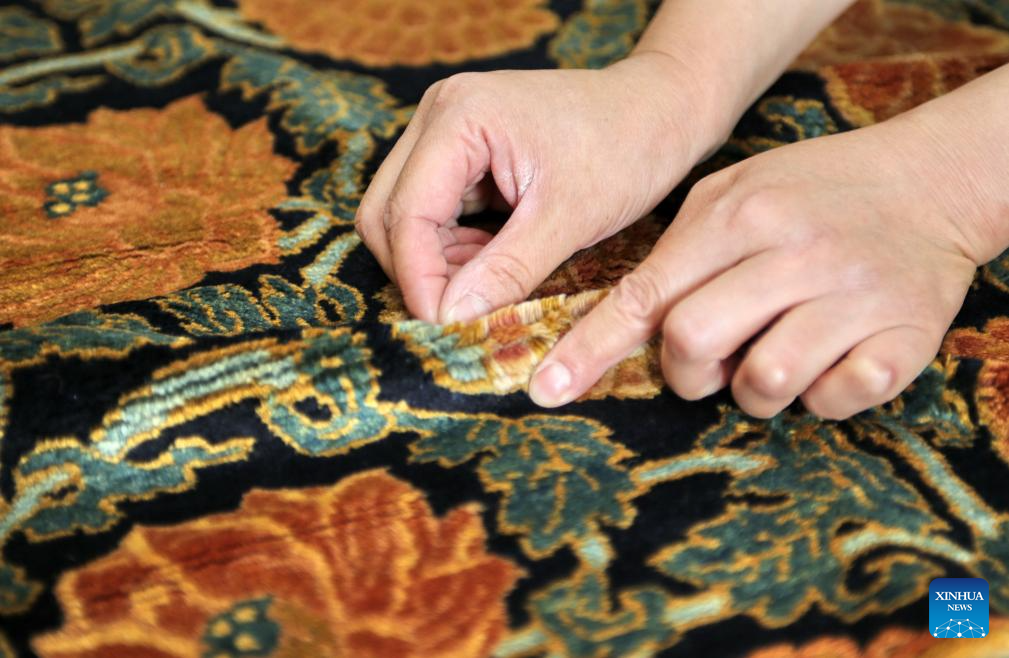
Ji Yu shows the details of a palace carpet at her studio in Beijing, capital of China, June 27, 2024. Beijing palace carpet is a splendid example of China's traditional carpet weaving techniques. Known for its intricate production processes and beautiful patterns, the palace carpet represents the pinnacle of Chinese weaving artistry. The production involves four main steps: dyeing with traditional Chinese herbs, pattern design, weaving and shaping, and finally, finishing touches. As one of the "Beijing Eight Imperial Handicrafts," the art of palace carpet was designated a national intangible cultural heritage in 2008.
Ji Yu, born in 1971 in central China's Henan Province, has dedicated over 30 years to the repair and creation of traditional palace carpets. In 1995, along with her husband Li Dongyang, she moved to Beijing to specialize in restoring ancient carpets.
Over the years, the couple has insisted on traditional dyeing and weaving techniques. During the process of repairing ancient carpets, the have found and mastered many long-lost ancient techniques. Last year, Ji Yu was accepted as an apprentice of Wang Guoying, a national-level inheritor of the palace carpet tradition. (Xinhua/Zhu Weixi)
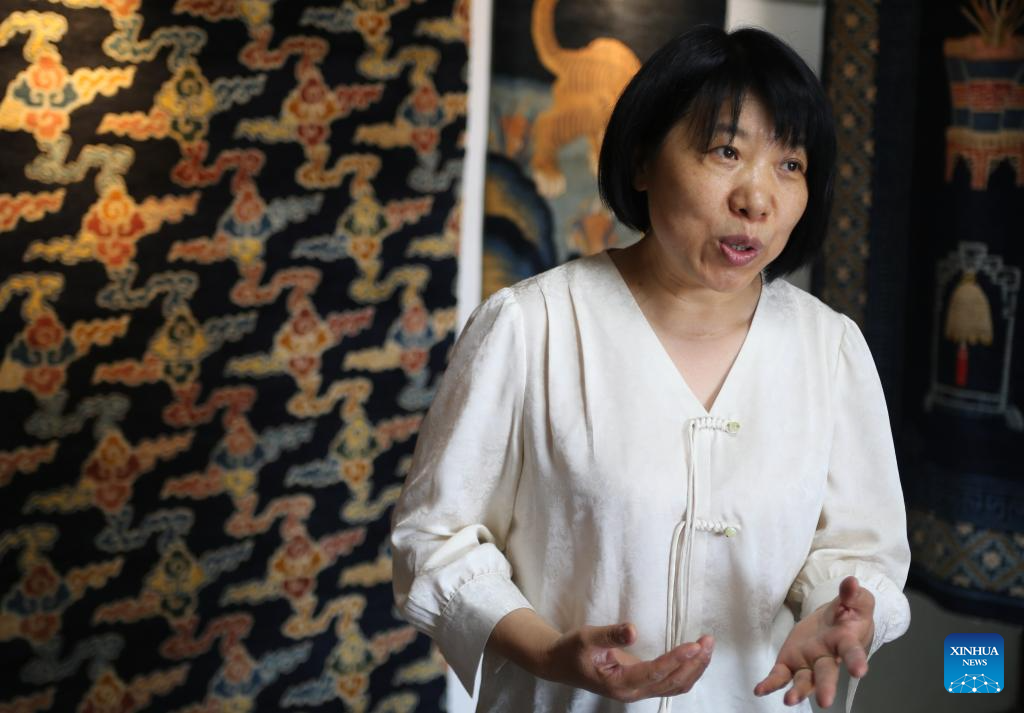
Ji Yu talks about palace carpet weaving at her studio in Beijing, capital of China, June 27, 2024. Beijing palace carpet is a splendid example of China's traditional carpet weaving techniques. Known for its intricate production processes and beautiful patterns, the palace carpet represents the pinnacle of Chinese weaving artistry. The production involves four main steps: dyeing with traditional Chinese herbs, pattern design, weaving and shaping, and finally, finishing touches. As one of the "Beijing Eight Imperial Handicrafts," the art of palace carpet was designated a national intangible cultural heritage in 2008.
Ji Yu, born in 1971 in central China's Henan Province, has dedicated over 30 years to the repair and creation of traditional palace carpets. In 1995, along with her husband Li Dongyang, she moved to Beijing to specialize in restoring ancient carpets.
Over the years, the couple has insisted on traditional dyeing and weaving techniques. During the process of repairing ancient carpets, the have found and mastered many long-lost ancient techniques. Last year, Ji Yu was accepted as an apprentice of Wang Guoying, a national-level inheritor of the palace carpet tradition. (Xinhua/Zhu Weixi)

Ji Yu draws a pattern for a palace carpet at her studio in Beijing, capital of China, June 27, 2024. Beijing palace carpet is a splendid example of China's traditional carpet weaving techniques. Known for its intricate production processes and beautiful patterns, the palace carpet represents the pinnacle of Chinese weaving artistry. The production involves four main steps: dyeing with traditional Chinese herbs, pattern design, weaving and shaping, and finally, finishing touches. As one of the "Beijing Eight Imperial Handicrafts," the art of palace carpet was designated a national intangible cultural heritage in 2008.
Ji Yu, born in 1971 in central China's Henan Province, has dedicated over 30 years to the repair and creation of traditional palace carpets. In 1995, along with her husband Li Dongyang, she moved to Beijing to specialize in restoring ancient carpets.
Over the years, the couple has insisted on traditional dyeing and weaving techniques. During the process of repairing ancient carpets, the have found and mastered many long-lost ancient techniques. Last year, Ji Yu was accepted as an apprentice of Wang Guoying, a national-level inheritor of the palace carpet tradition. (Xinhua/Zhu Weixi)
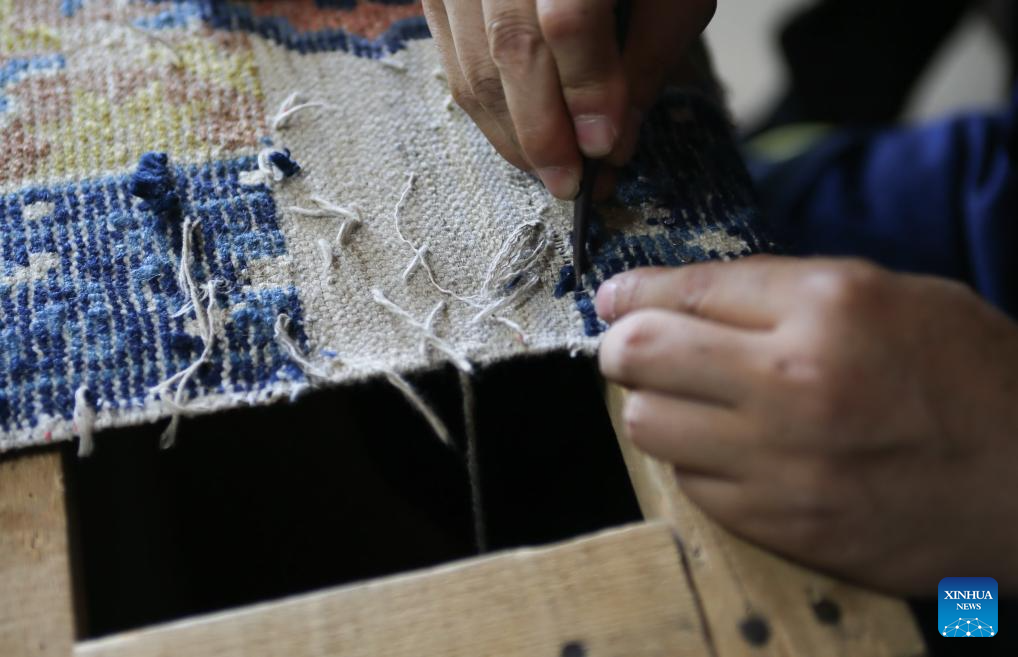
Ji Yu's husband Li Dongyang repairs a palace carpet at her studio in Beijing, capital of China, June 27, 2024. Beijing palace carpet is a splendid example of China's traditional carpet weaving techniques. Known for its intricate production processes and beautiful patterns, the palace carpet represents the pinnacle of Chinese weaving artistry. The production involves four main steps: dyeing with traditional Chinese herbs, pattern design, weaving and shaping, and finally, finishing touches. As one of the "Beijing Eight Imperial Handicrafts," the art of palace carpet was designated a national intangible cultural heritage in 2008.
Ji Yu, born in 1971 in central China's Henan Province, has dedicated over 30 years to the repair and creation of traditional palace carpets. In 1995, along with her husband Li Dongyang, she moved to Beijing to specialize in restoring ancient carpets.
Over the years, the couple has insisted on traditional dyeing and weaving techniques. During the process of repairing ancient carpets, the have found and mastered many long-lost ancient techniques. Last year, Ji Yu was accepted as an apprentice of Wang Guoying, a national-level inheritor of the palace carpet tradition. (Xinhua/Zhu Weixi)
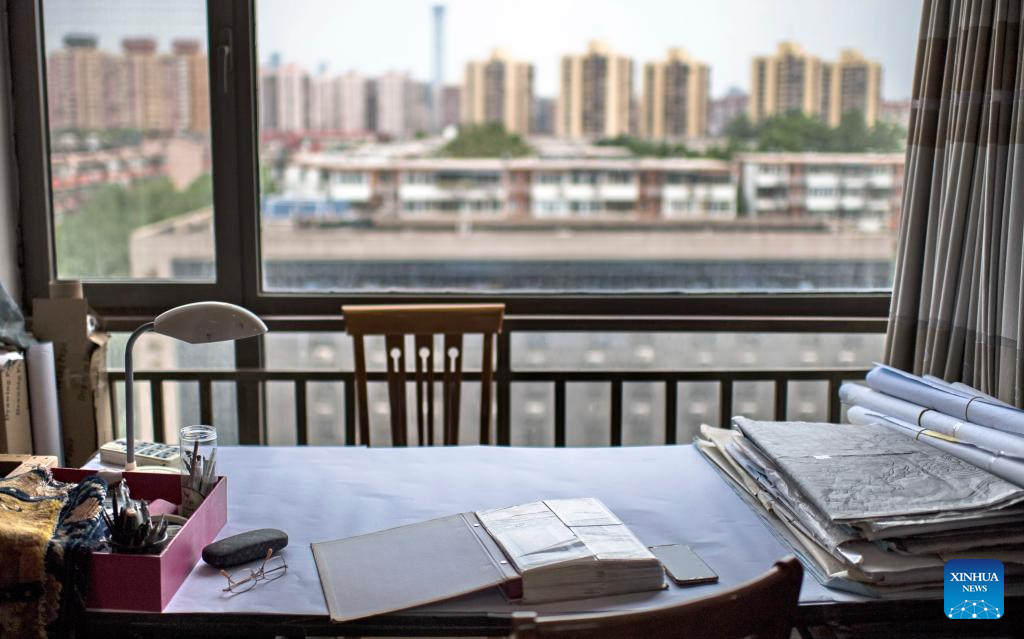
This photo taken on June 27, 2024 shows a scene at the studio of Ji Yu in Beijing, capital of China. Beijing palace carpet is a splendid example of China's traditional carpet weaving techniques. Known for its intricate production processes and beautiful patterns, the palace carpet represents the pinnacle of Chinese weaving artistry. The production involves four main steps: dyeing with traditional Chinese herbs, pattern design, weaving and shaping, and finally, finishing touches. As one of the "Beijing Eight Imperial Handicrafts," the art of palace carpet was designated a national intangible cultural heritage in 2008.
Ji Yu, born in 1971 in central China's Henan Province, has dedicated over 30 years to the repair and creation of traditional palace carpets. In 1995, along with her husband Li Dongyang, she moved to Beijing to specialize in restoring ancient carpets.
Over the years, the couple has insisted on traditional dyeing and weaving techniques. During the process of repairing ancient carpets, the have found and mastered many long-lost ancient techniques. Last year, Ji Yu was accepted as an apprentice of Wang Guoying, a national-level inheritor of the palace carpet tradition. (Xinhua/Zhang Haofu)
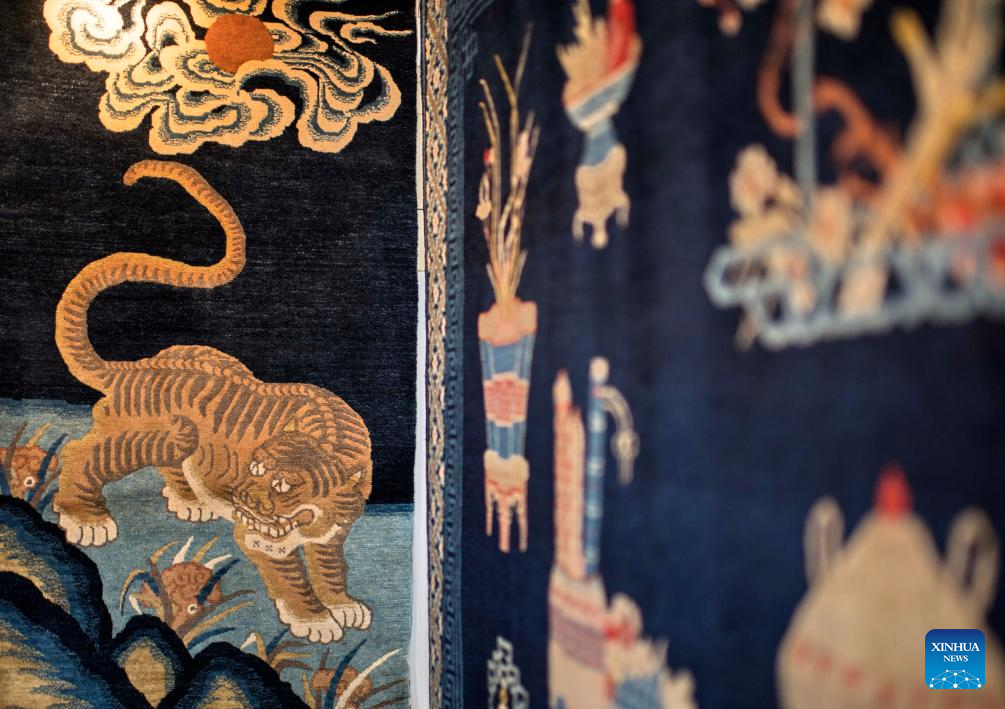
This photo taken on June 27, 2024 shows the details of a palace carpet displayed at the studio of Ji Yu in Beijing, capital of China. Beijing palace carpet is a splendid example of China's traditional carpet weaving techniques. Known for its intricate production processes and beautiful patterns, the palace carpet represents the pinnacle of Chinese weaving artistry. The production involves four main steps: dyeing with traditional Chinese herbs, pattern design, weaving and shaping, and finally, finishing touches. As one of the "Beijing Eight Imperial Handicrafts," the art of palace carpet was designated a national intangible cultural heritage in 2008.
Ji Yu, born in 1971 in central China's Henan Province, has dedicated over 30 years to the repair and creation of traditional palace carpets. In 1995, along with her husband Li Dongyang, she moved to Beijing to specialize in restoring ancient carpets.
Over the years, the couple has insisted on traditional dyeing and weaving techniques. During the process of repairing ancient carpets, the have found and mastered many long-lost ancient techniques. Last year, Ji Yu was accepted as an apprentice of Wang Guoying, a national-level inheritor of the palace carpet tradition. (Xinhua/Zhang Haofu)
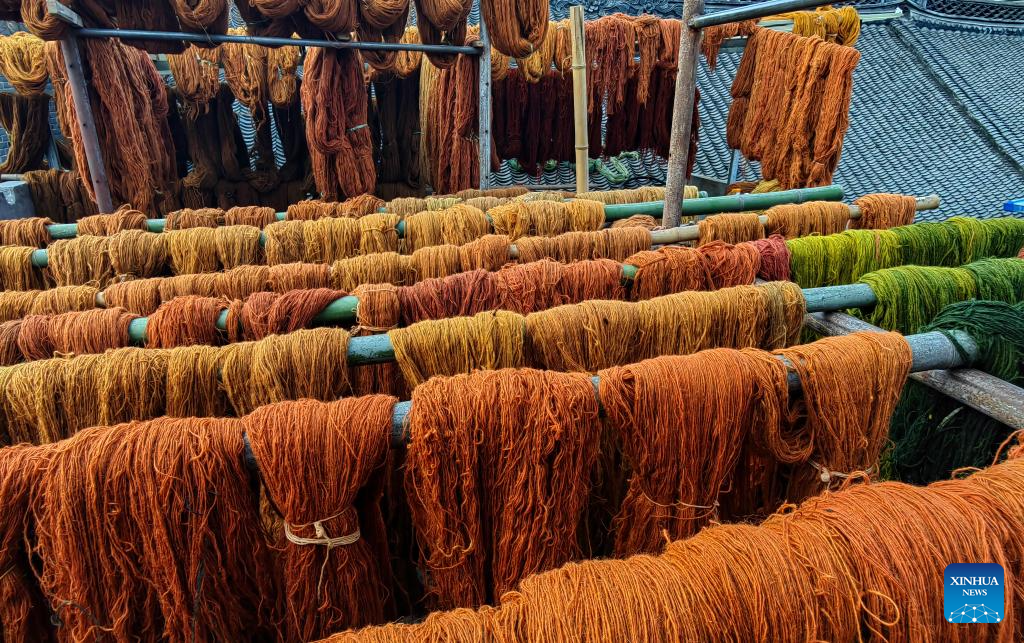
This undated photo shows materials dyed with Chinese herbs and medicines for making palace carpet at the factory of Ji Yu in central China's Henan Province. Beijing palace carpet is a splendid example of China's traditional carpet weaving techniques. Known for its intricate production processes and beautiful patterns, the palace carpet represents the pinnacle of Chinese weaving artistry. The production involves four main steps: dyeing with traditional Chinese herbs, pattern design, weaving and shaping, and finally, finishing touches. As one of the "Beijing Eight Imperial Handicrafts," the art of palace carpet was designated a national intangible cultural heritage in 2008.
Ji Yu, born in 1971 in central China's Henan Province, has dedicated over 30 years to the repair and creation of traditional palace carpets. In 1995, along with her husband Li Dongyang, she moved to Beijing to specialize in restoring ancient carpets.
Over the years, the couple has insisted on traditional dyeing and weaving techniques. During the process of repairing ancient carpets, the have found and mastered many long-lost ancient techniques. Last year, Ji Yu was accepted as an apprentice of Wang Guoying, a national-level inheritor of the palace carpet tradition. (Xinhua)

Ji Yu shows a palace carpet at her studio in Beijing, capital of China, June 27, 2024. Beijing palace carpet is a splendid example of China's traditional carpet weaving techniques. Known for its intricate production processes and beautiful patterns, the palace carpet represents the pinnacle of Chinese weaving artistry. The production involves four main steps: dyeing with traditional Chinese herbs, pattern design, weaving and shaping, and finally, finishing touches. As one of the "Beijing Eight Imperial Handicrafts," the art of palace carpet was designated a national intangible cultural heritage in 2008.
Ji Yu, born in 1971 in central China's Henan Province, has dedicated over 30 years to the repair and creation of traditional palace carpets. In 1995, along with her husband Li Dongyang, she moved to Beijing to specialize in restoring ancient carpets.
Over the years, the couple has insisted on traditional dyeing and weaving techniques. During the process of repairing ancient carpets, the have found and mastered many long-lost ancient techniques. Last year, Ji Yu was accepted as an apprentice of Wang Guoying, a national-level inheritor of the palace carpet tradition. (Xinhua/Zhu Weixi)
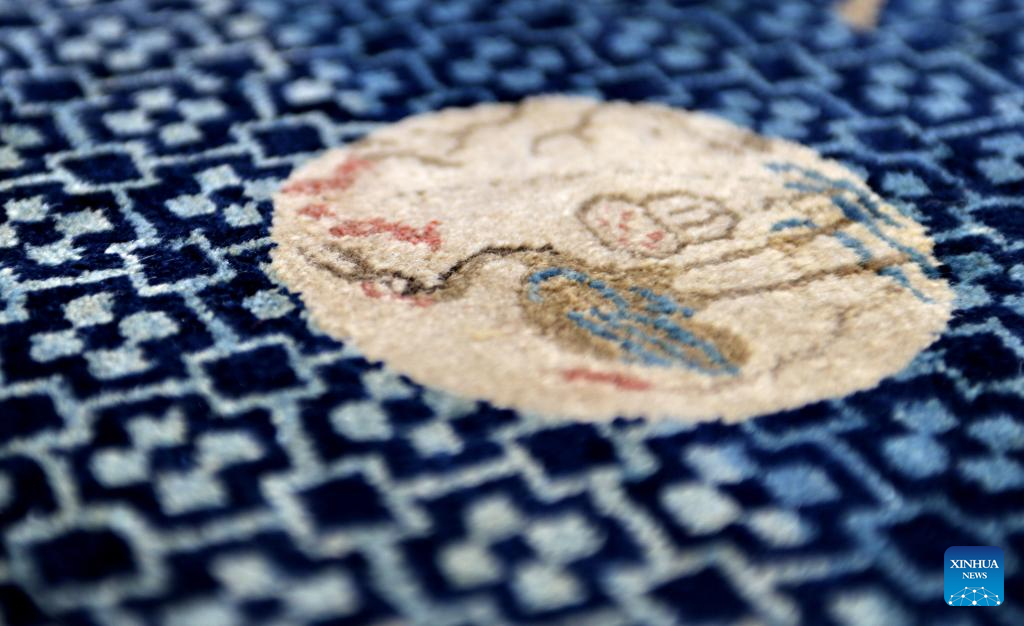
This photo taken on June 27, 2024 shows a detail of a palace carpet displayed at the studio of Ji Yu in Beijing, capital of China. Beijing palace carpet is a splendid example of China's traditional carpet weaving techniques. Known for its intricate production processes and beautiful patterns, the palace carpet represents the pinnacle of Chinese weaving artistry. The production involves four main steps: dyeing with traditional Chinese herbs, pattern design, weaving and shaping, and finally, finishing touches. As one of the "Beijing Eight Imperial Handicrafts," the art of palace carpet was designated a national intangible cultural heritage in 2008.
Ji Yu, born in 1971 in central China's Henan Province, has dedicated over 30 years to the repair and creation of traditional palace carpets. In 1995, along with her husband Li Dongyang, she moved to Beijing to specialize in restoring ancient carpets.
Over the years, the couple has insisted on traditional dyeing and weaving techniques. During the process of repairing ancient carpets, the have found and mastered many long-lost ancient techniques. Last year, Ji Yu was accepted as an apprentice of Wang Guoying, a national-level inheritor of the palace carpet tradition. (Xinhua/Zhu Weixi)

Wang Guoying repairs a palace carpet at the studio of Ji Yu in Beijing, capital of China, June 27, 2024. Beijing palace carpet is a splendid example of China's traditional carpet weaving techniques. Known for its intricate production processes and beautiful patterns, the palace carpet represents the pinnacle of Chinese weaving artistry. The production involves four main steps: dyeing with traditional Chinese herbs, pattern design, weaving and shaping, and finally, finishing touches. As one of the "Beijing Eight Imperial Handicrafts," the art of palace carpet was designated a national intangible cultural heritage in 2008.
Ji Yu, born in 1971 in central China's Henan Province, has dedicated over 30 years to the repair and creation of traditional palace carpets. In 1995, along with her husband Li Dongyang, she moved to Beijing to specialize in restoring ancient carpets.
Over the years, the couple has insisted on traditional dyeing and weaving techniques. During the process of repairing ancient carpets, the have found and mastered many long-lost ancient techniques. Last year, Ji Yu was accepted as an apprentice of Wang Guoying, a national-level inheritor of the palace carpet tradition. (Xinhua/Zhu Weixi)
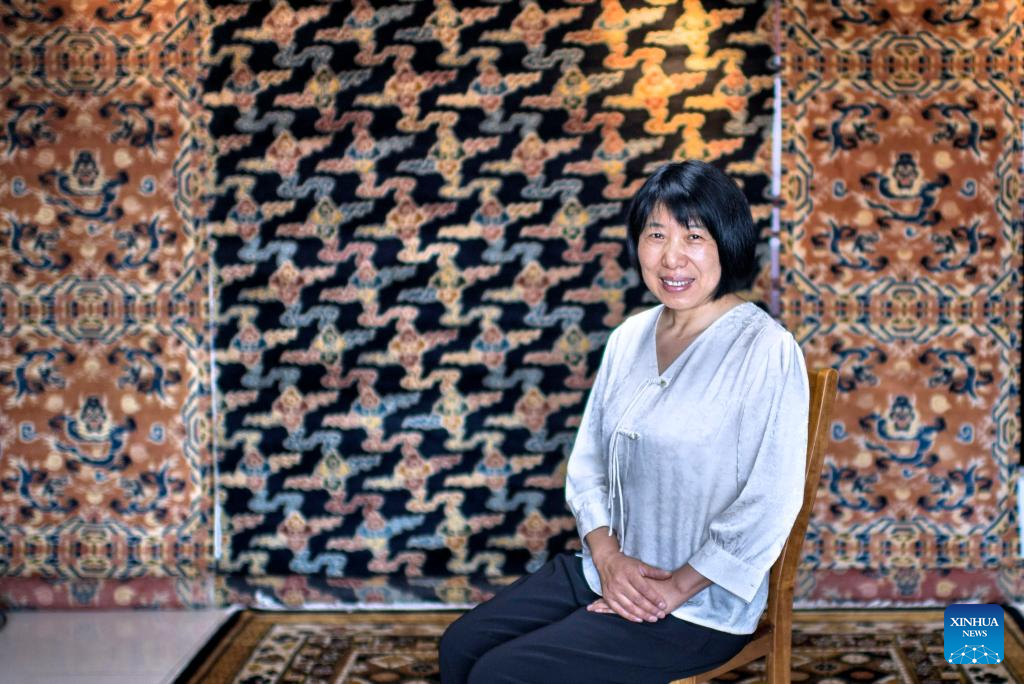
Ji Yu poses for a photo at her studio in Beijing, capital of China, June 27, 2024. Beijing palace carpet is a splendid example of China's traditional carpet weaving techniques. Known for its intricate production processes and beautiful patterns, the palace carpet represents the pinnacle of Chinese weaving artistry. The production involves four main steps: dyeing with traditional Chinese herbs, pattern design, weaving and shaping, and finally, finishing touches. As one of the "Beijing Eight Imperial Handicrafts," the art of palace carpet was designated a national intangible cultural heritage in 2008.
Ji Yu, born in 1971 in central China's Henan Province, has dedicated over 30 years to the repair and creation of traditional palace carpets. In 1995, along with her husband Li Dongyang, she moved to Beijing to specialize in restoring ancient carpets.
Over the years, the couple has insisted on traditional dyeing and weaving techniques. During the process of repairing ancient carpets, the have found and mastered many long-lost ancient techniques. Last year, Ji Yu was accepted as an apprentice of Wang Guoying, a national-level inheritor of the palace carpet tradition. (Xinhua/Zhang Haofu)
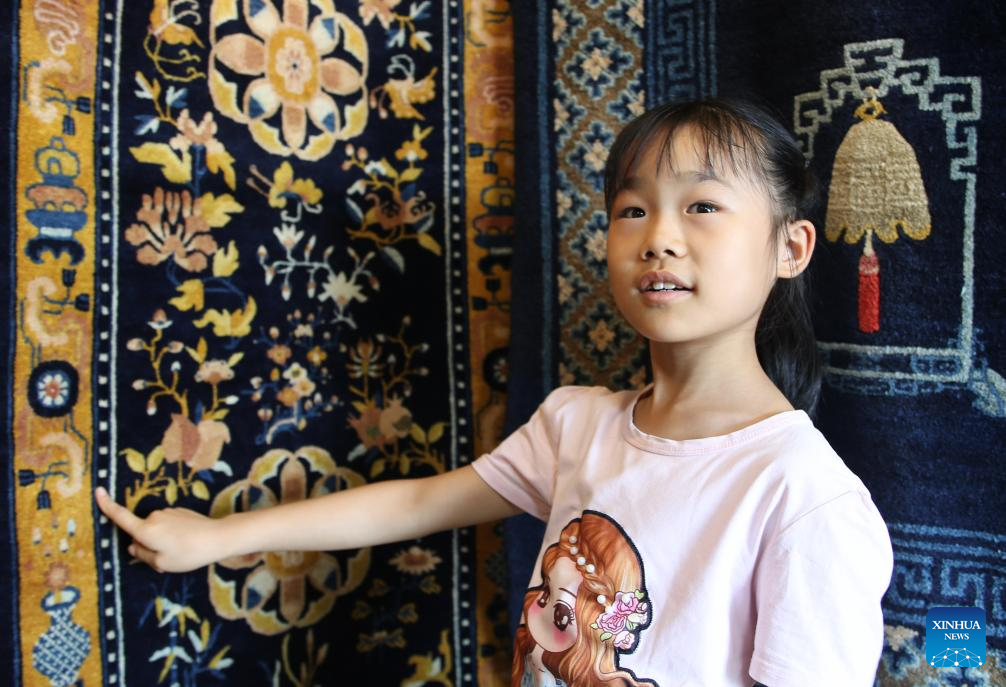
Ji Yu's daughter shows a palace carpet at Ji Yu's studio in Beijing, capital of China, June 27, 2024. Beijing palace carpet is a splendid example of China's traditional carpet weaving techniques. Known for its intricate production processes and beautiful patterns, the palace carpet represents the pinnacle of Chinese weaving artistry. The production involves four main steps: dyeing with traditional Chinese herbs, pattern design, weaving and shaping, and finally, finishing touches. As one of the "Beijing Eight Imperial Handicrafts," the art of palace carpet was designated a national intangible cultural heritage in 2008.
Ji Yu, born in 1971 in central China's Henan Province, has dedicated over 30 years to the repair and creation of traditional palace carpets. In 1995, along with her husband Li Dongyang, she moved to Beijing to specialize in restoring ancient carpets.
Over the years, the couple has insisted on traditional dyeing and weaving techniques. During the process of repairing ancient carpets, the have found and mastered many long-lost ancient techniques. Last year, Ji Yu was accepted as an apprentice of Wang Guoying, a national-level inheritor of the palace carpet tradition. (Xinhua/Zhu Weixi)
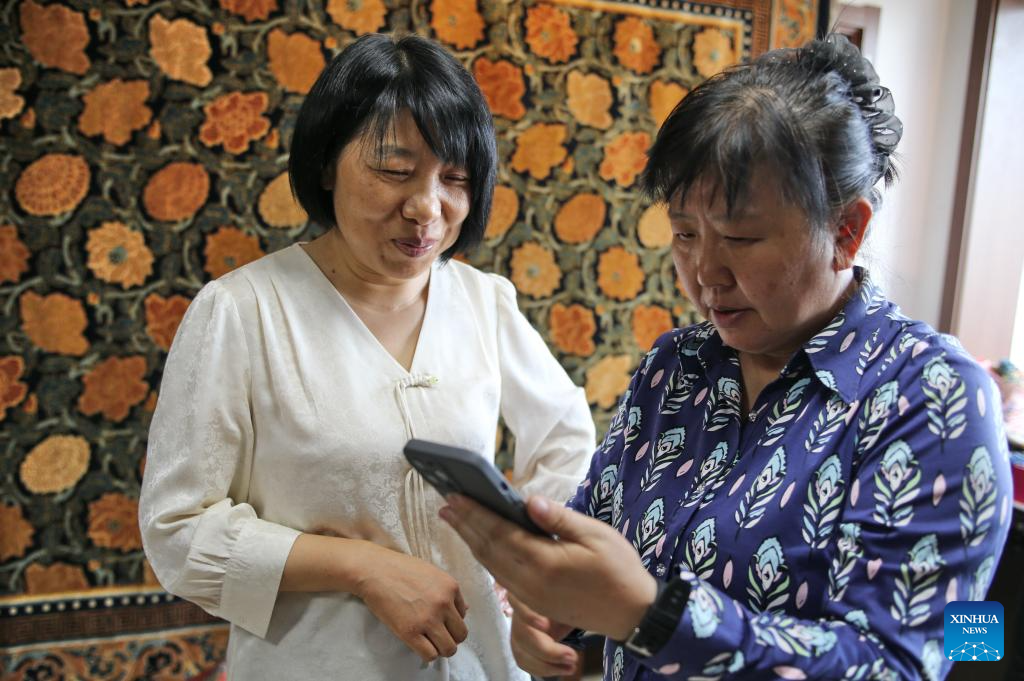
Ji Yu (L) and Wang Guoying discuss on the design patterns for a palace carpet in Beijing, capital of China, June 27, 2024. Beijing palace carpet is a splendid example of China's traditional carpet weaving techniques. Known for its intricate production processes and beautiful patterns, the palace carpet represents the pinnacle of Chinese weaving artistry. The production involves four main steps: dyeing with traditional Chinese herbs, pattern design, weaving and shaping, and finally, finishing touches. As one of the "Beijing Eight Imperial Handicrafts," the art of palace carpet was designated a national intangible cultural heritage in 2008.
Ji Yu, born in 1971 in central China's Henan Province, has dedicated over 30 years to the repair and creation of traditional palace carpets. In 1995, along with her husband Li Dongyang, she moved to Beijing to specialize in restoring ancient carpets.
Over the years, the couple has insisted on traditional dyeing and weaving techniques. During the process of repairing ancient carpets, the have found and mastered many long-lost ancient techniques. Last year, Ji Yu was accepted as an apprentice of Wang Guoying, a national-level inheritor of the palace carpet tradition. (Xinhua/Zhu Weixi)

This photo taken on June 27, 2024 shows a design pattern of a palace carpet displayed at the studio of Ji Yu in Beijing, capital of China. Beijing palace carpet is a splendid example of China's traditional carpet weaving techniques. Known for its intricate production processes and beautiful patterns, the palace carpet represents the pinnacle of Chinese weaving artistry. The production involves four main steps: dyeing with traditional Chinese herbs, pattern design, weaving and shaping, and finally, finishing touches. As one of the "Beijing Eight Imperial Handicrafts," the art of palace carpet was designated a national intangible cultural heritage in 2008.
Ji Yu, born in 1971 in central China's Henan Province, has dedicated over 30 years to the repair and creation of traditional palace carpets. In 1995, along with her husband Li Dongyang, she moved to Beijing to specialize in restoring ancient carpets.
Over the years, the couple has insisted on traditional dyeing and weaving techniques. During the process of repairing ancient carpets, the have found and mastered many long-lost ancient techniques. Last year, Ji Yu was accepted as an apprentice of Wang Guoying, a national-level inheritor of the palace carpet tradition. (Xinhua/Zhang Haofu)
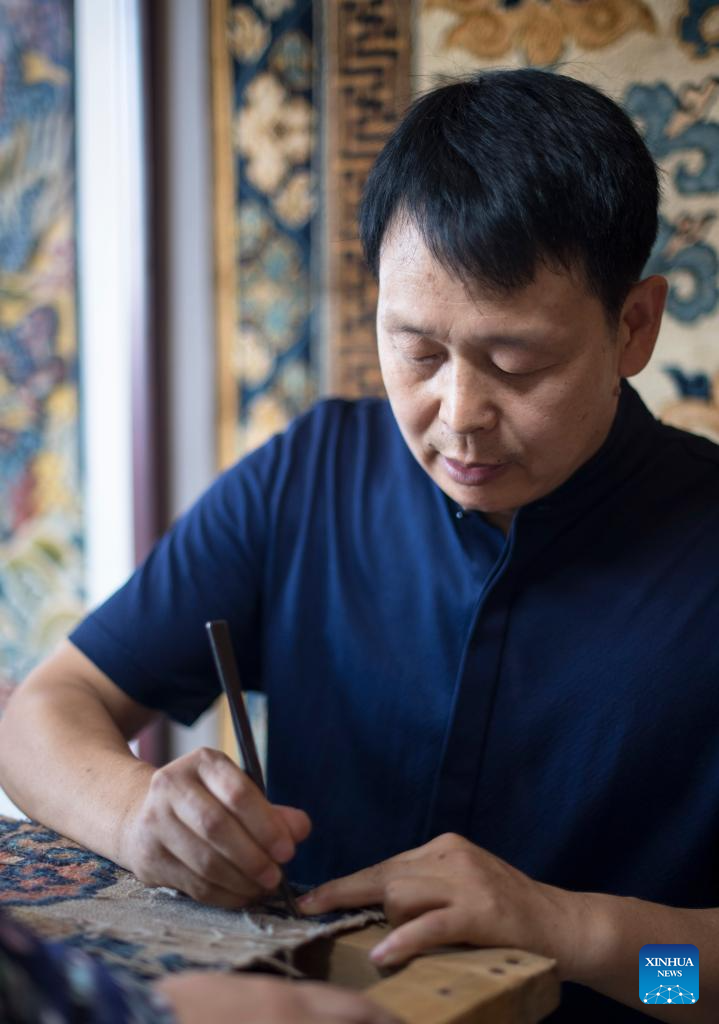
Ji Yu's husband Li Dongyang repairs a palace carpet at her studio in Beijing, capital of China, June 27, 2024. Beijing palace carpet is a splendid example of China's traditional carpet weaving techniques. Known for its intricate production processes and beautiful patterns, the palace carpet represents the pinnacle of Chinese weaving artistry. The production involves four main steps: dyeing with traditional Chinese herbs, pattern design, weaving and shaping, and finally, finishing touches. As one of the "Beijing Eight Imperial Handicrafts," the art of palace carpet was designated a national intangible cultural heritage in 2008.
Ji Yu, born in 1971 in central China's Henan Province, has dedicated over 30 years to the repair and creation of traditional palace carpets. In 1995, along with her husband Li Dongyang, she moved to Beijing to specialize in restoring ancient carpets.
Over the years, the couple has insisted on traditional dyeing and weaving techniques. During the process of repairing ancient carpets, the have found and mastered many long-lost ancient techniques. Last year, Ji Yu was accepted as an apprentice of Wang Guoying, a national-level inheritor of the palace carpet tradition. (Xinhua/Zhang Haofu)
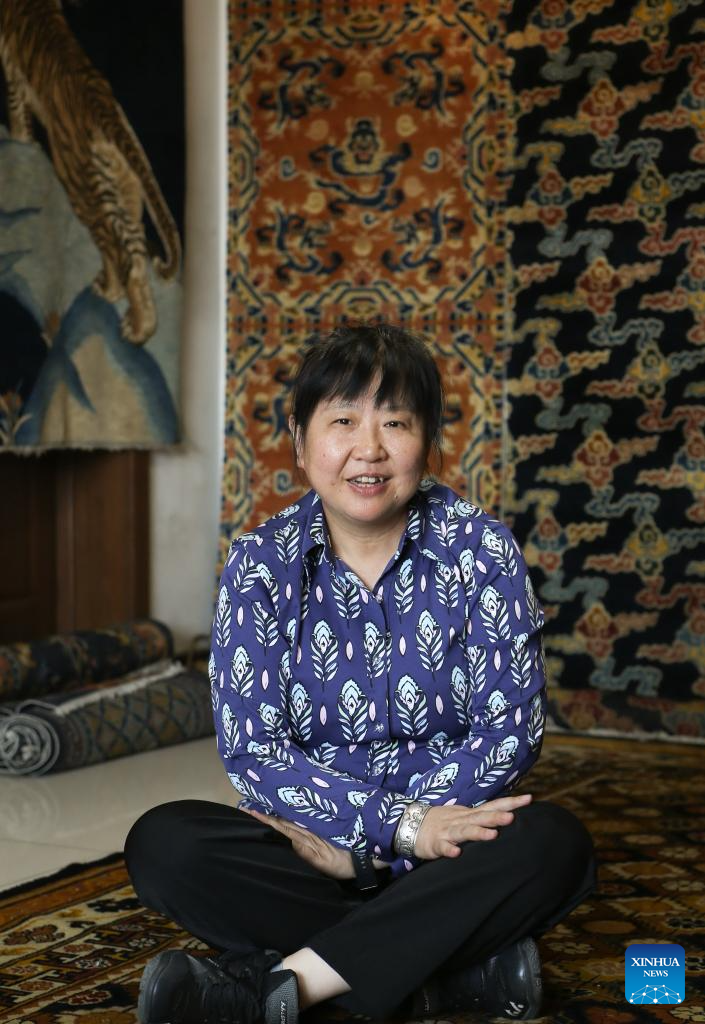
Wang Guoying sits on a palace carpet at the studio of Ji Yu in Beijing, capital of China, June 27, 2024. Beijing palace carpet is a splendid example of China's traditional carpet weaving techniques. Known for its intricate production processes and beautiful patterns, the palace carpet represents the pinnacle of Chinese weaving artistry. The production involves four main steps: dyeing with traditional Chinese herbs, pattern design, weaving and shaping, and finally, finishing touches. As one of the "Beijing Eight Imperial Handicrafts," the art of palace carpet was designated a national intangible cultural heritage in 2008.
Ji Yu, born in 1971 in central China's Henan Province, has dedicated over 30 years to the repair and creation of traditional palace carpets. In 1995, along with her husband Li Dongyang, she moved to Beijing to specialize in restoring ancient carpets.
Over the years, the couple has insisted on traditional dyeing and weaving techniques. During the process of repairing ancient carpets, the have found and mastered many long-lost ancient techniques. Last year, Ji Yu was accepted as an apprentice of Wang Guoying, a national-level inheritor of the palace carpet tradition. (Xinhua/Zhu Weixi)
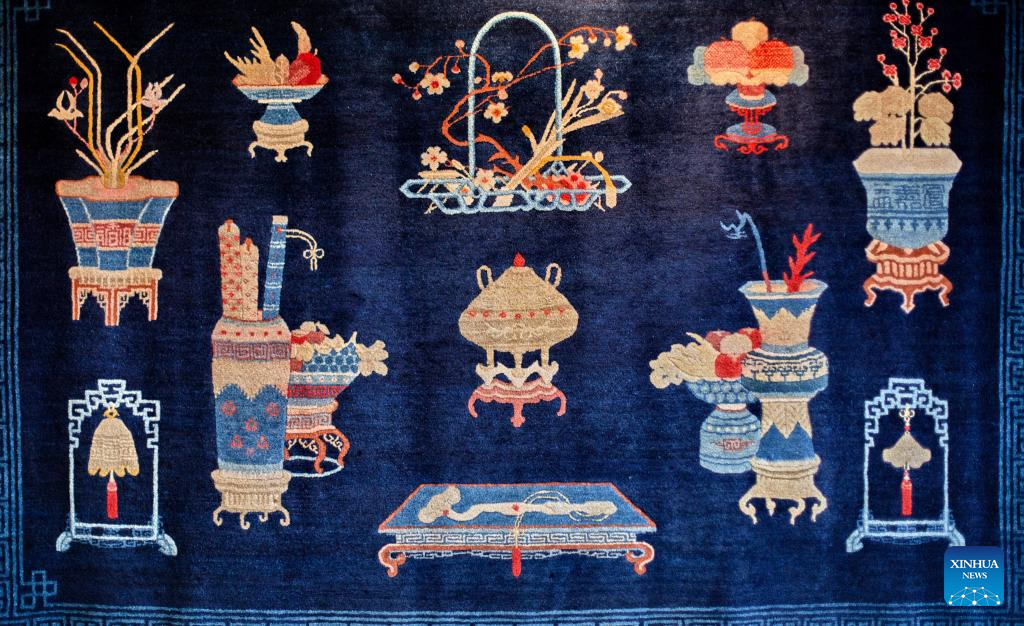
This photo taken on June 27, 2024 shows a palace carpet displayed at the studio of Ji Yu in Beijing, capital of China. Beijing palace carpet is a splendid example of China's traditional carpet weaving techniques. Known for its intricate production processes and beautiful patterns, the palace carpet represents the pinnacle of Chinese weaving artistry. The production involves four main steps: dyeing with traditional Chinese herbs, pattern design, weaving and shaping, and finally, finishing touches. As one of the "Beijing Eight Imperial Handicrafts," the art of palace carpet was designated a national intangible cultural heritage in 2008.
Ji Yu, born in 1971 in central China's Henan Province, has dedicated over 30 years to the repair and creation of traditional palace carpets. In 1995, along with her husband Li Dongyang, she moved to Beijing to specialize in restoring ancient carpets.
Over the years, the couple has insisted on traditional dyeing and weaving techniques. During the process of repairing ancient carpets, the have found and mastered many long-lost ancient techniques. Last year, Ji Yu was accepted as an apprentice of Wang Guoying, a national-level inheritor of the palace carpet tradition. (Xinhua/Tian Weiwei)
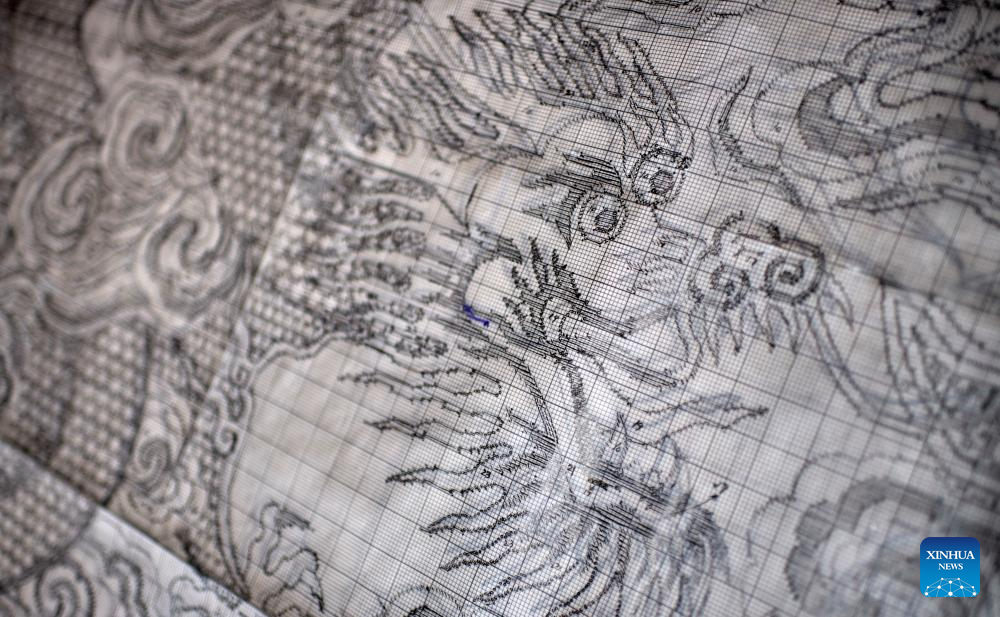
This photo taken on June 27, 2024 shows the design pattern for a palace carpet displayed at the studio of Ji Yu in Beijing, capital of China. Beijing palace carpet is a splendid example of China's traditional carpet weaving techniques. Known for its intricate production processes and beautiful patterns, the palace carpet represents the pinnacle of Chinese weaving artistry. The production involves four main steps: dyeing with traditional Chinese herbs, pattern design, weaving and shaping, and finally, finishing touches. As one of the "Beijing Eight Imperial Handicrafts," the art of palace carpet was designated a national intangible cultural heritage in 2008.
Ji Yu, born in 1971 in central China's Henan Province, has dedicated over 30 years to the repair and creation of traditional palace carpets. In 1995, along with her husband Li Dongyang, she moved to Beijing to specialize in restoring ancient carpets.
Over the years, the couple has insisted on traditional dyeing and weaving techniques. During the process of repairing ancient carpets, the have found and mastered many long-lost ancient techniques. Last year, Ji Yu was accepted as an apprentice of Wang Guoying, a national-level inheritor of the palace carpet tradition. (Xinhua/Zhang Haofu)
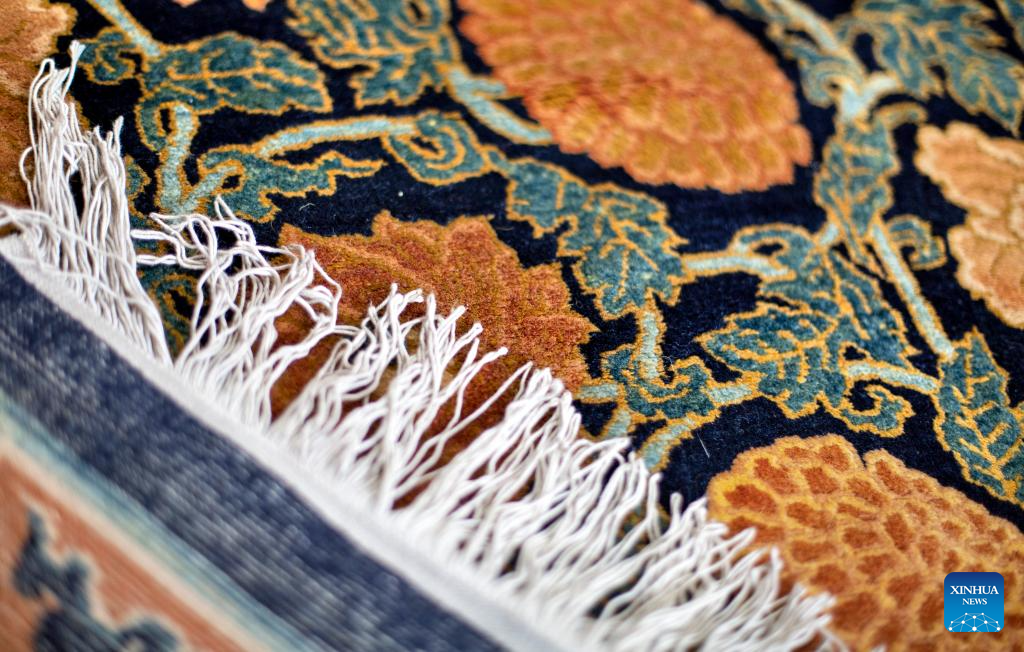
This photo taken on June 27, 2024 shows a detail of a palace carpet displayed at the studio of Ji Yu in Beijing, capital of China. Beijing palace carpet is a splendid example of China's traditional carpet weaving techniques. Known for its intricate production processes and beautiful patterns, the palace carpet represents the pinnacle of Chinese weaving artistry. The production involves four main steps: dyeing with traditional Chinese herbs, pattern design, weaving and shaping, and finally, finishing touches. As one of the "Beijing Eight Imperial Handicrafts," the art of palace carpet was designated a national intangible cultural heritage in 2008.
Ji Yu, born in 1971 in central China's Henan Province, has dedicated over 30 years to the repair and creation of traditional palace carpets. In 1995, along with her husband Li Dongyang, she moved to Beijing to specialize in restoring ancient carpets.
Over the years, the couple has insisted on traditional dyeing and weaving techniques. During the process of repairing ancient carpets, the have found and mastered many long-lost ancient techniques. Last year, Ji Yu was accepted as an apprentice of Wang Guoying, a national-level inheritor of the palace carpet tradition. (Xinhua/Tian Weiwei)
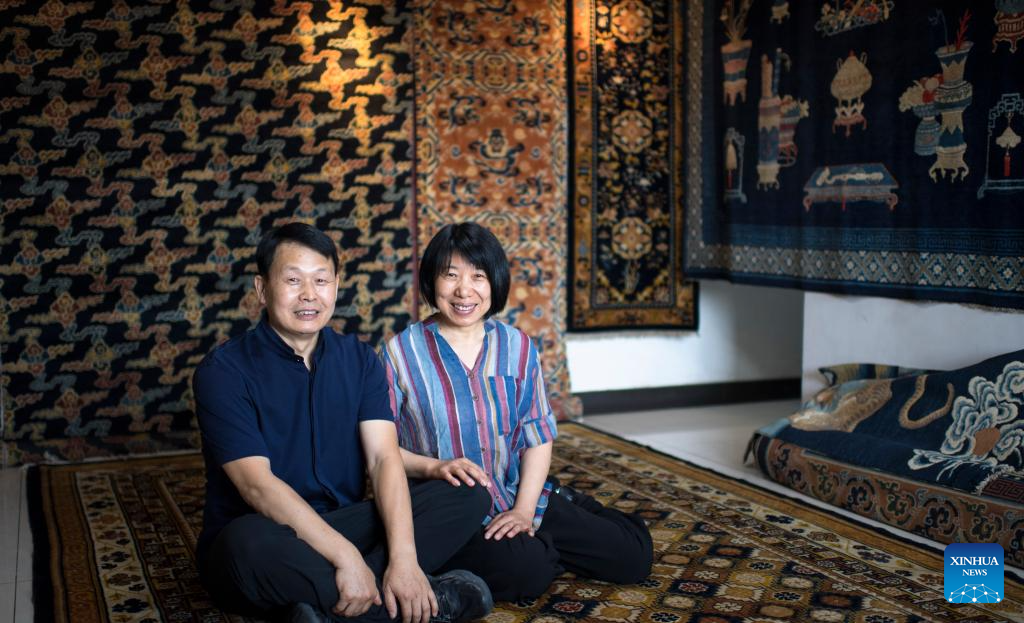
Ji Yu poses for a photo with her husband Li Dongyang at her studio in Beijing, capital of China, June 27, 2024. Beijing palace carpet is a splendid example of China's traditional carpet weaving techniques. Known for its intricate production processes and beautiful patterns, the palace carpet represents the pinnacle of Chinese weaving artistry. The production involves four main steps: dyeing with traditional Chinese herbs, pattern design, weaving and shaping, and finally, finishing touches. As one of the "Beijing Eight Imperial Handicrafts," the art of palace carpet was designated a national intangible cultural heritage in 2008.
Ji Yu, born in 1971 in central China's Henan Province, has dedicated over 30 years to the repair and creation of traditional palace carpets. In 1995, along with her husband Li Dongyang, she moved to Beijing to specialize in restoring ancient carpets.
Over the years, the couple has insisted on traditional dyeing and weaving techniques. During the process of repairing ancient carpets, the have found and mastered many long-lost ancient techniques. Last year, Ji Yu was accepted as an apprentice of Wang Guoying, a national-level inheritor of the palace carpet tradition. (Xinhua/Zhang Haofu)
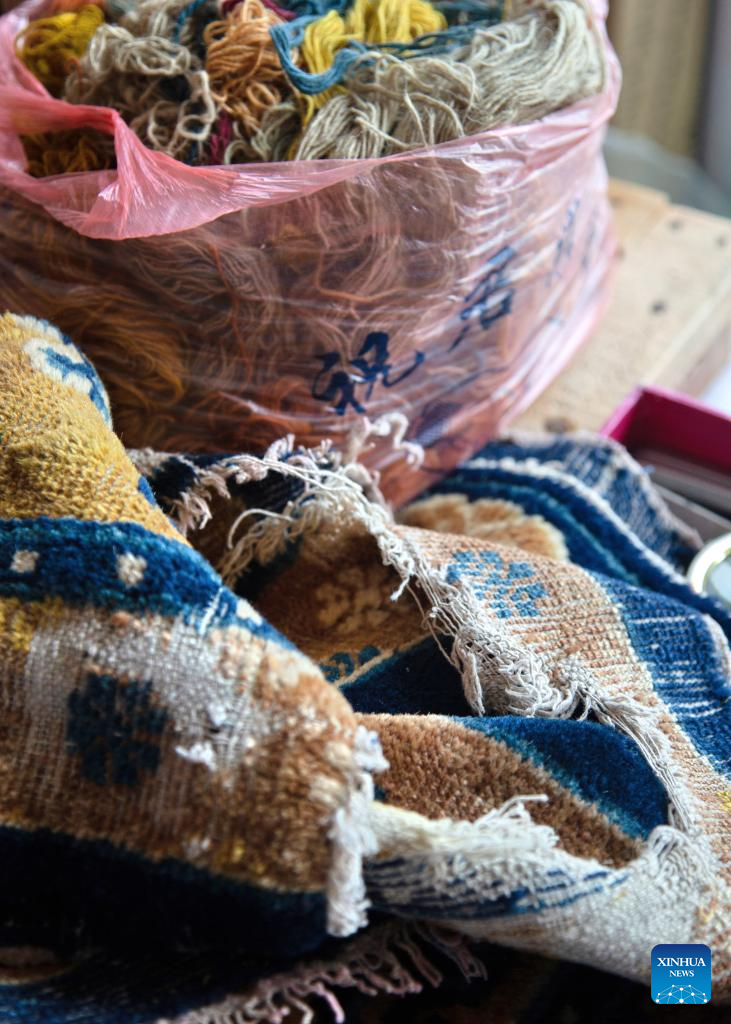
This photo taken on June 27, 2024 shows a palace carpet waiting for repair at the studio of Ji Yu in Beijing, capital of China. Beijing palace carpet is a splendid example of China's traditional carpet weaving techniques. Known for its intricate production processes and beautiful patterns, the palace carpet represents the pinnacle of Chinese weaving artistry. The production involves four main steps: dyeing with traditional Chinese herbs, pattern design, weaving and shaping, and finally, finishing touches. As one of the "Beijing Eight Imperial Handicrafts," the art of palace carpet was designated a national intangible cultural heritage in 2008.
Ji Yu, born in 1971 in central China's Henan Province, has dedicated over 30 years to the repair and creation of traditional palace carpets. In 1995, along with her husband Li Dongyang, she moved to Beijing to specialize in restoring ancient carpets.
Over the years, the couple has insisted on traditional dyeing and weaving techniques. During the process of repairing ancient carpets, the have found and mastered many long-lost ancient techniques. Last year, Ji Yu was accepted as an apprentice of Wang Guoying, a national-level inheritor of the palace carpet tradition. (Xinhua/Tian Weiwei)
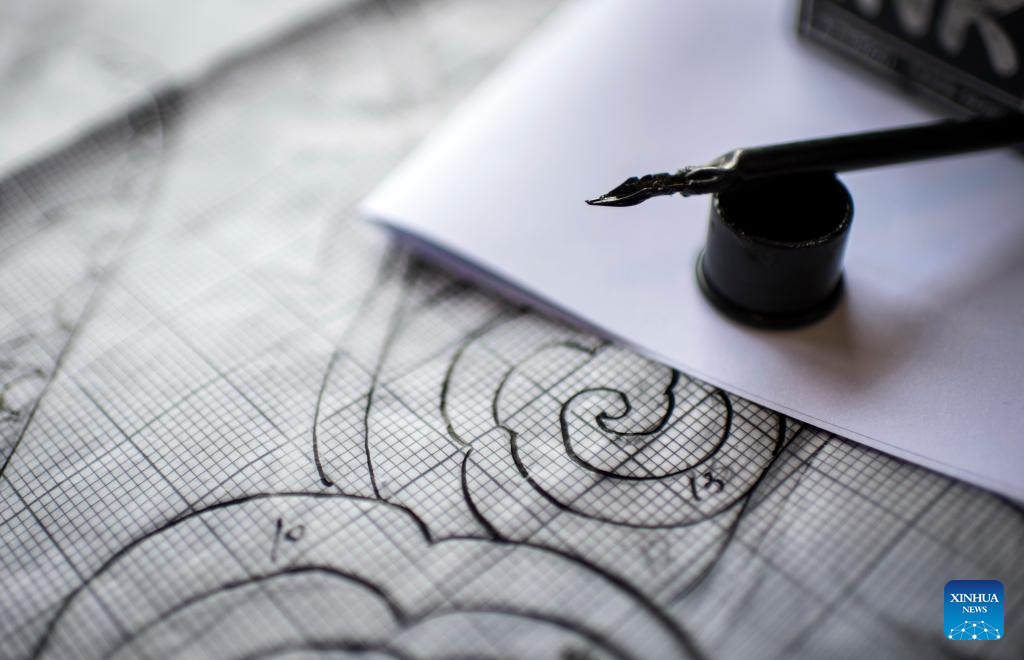
A design pattern of palace carpet is seen at the studio of Ji Yu in Beijing, capital of China, June 27, 2024. Beijing palace carpet is a splendid example of China's traditional carpet weaving techniques. Known for its intricate production processes and beautiful patterns, the palace carpet represents the pinnacle of Chinese weaving artistry. The production involves four main steps: dyeing with traditional Chinese herbs, pattern design, weaving and shaping, and finally, finishing touches. As one of the "Beijing Eight Imperial Handicrafts," the art of palace carpet was designated a national intangible cultural heritage in 2008.
Ji Yu, born in 1971 in central China's Henan Province, has dedicated over 30 years to the repair and creation of traditional palace carpets. In 1995, along with her husband Li Dongyang, she moved to Beijing to specialize in restoring ancient carpets.
Over the years, the couple has insisted on traditional dyeing and weaving techniques. During the process of repairing ancient carpets, the have found and mastered many long-lost ancient techniques. Last year, Ji Yu was accepted as an apprentice of Wang Guoying, a national-level inheritor of the palace carpet tradition. (Xinhua/Zhang Haofu)
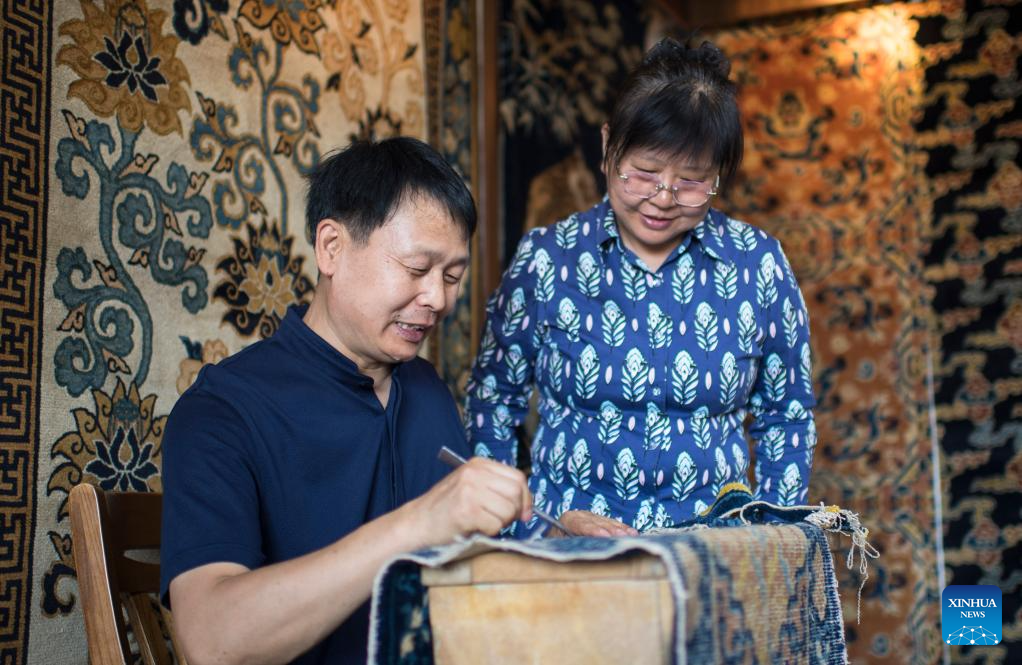
Ji Yu's husband Li Dongyang (L) repairs a palace carpet with Wang Guoying standing by at Ji Yu's studio in Beijing, capital of China, June 27, 2024. Beijing palace carpet is a splendid example of China's traditional carpet weaving techniques. Known for its intricate production processes and beautiful patterns, the palace carpet represents the pinnacle of Chinese weaving artistry. The production involves four main steps: dyeing with traditional Chinese herbs, pattern design, weaving and shaping, and finally, finishing touches. As one of the "Beijing Eight Imperial Handicrafts," the art of palace carpet was designated a national intangible cultural heritage in 2008.
Ji Yu, born in 1971 in central China's Henan Province, has dedicated over 30 years to the repair and creation of traditional palace carpets. In 1995, along with her husband Li Dongyang, she moved to Beijing to specialize in restoring ancient carpets.
Over the years, the couple has insisted on traditional dyeing and weaving techniques. During the process of repairing ancient carpets, the have found and mastered many long-lost ancient techniques. Last year, Ji Yu was accepted as an apprentice of Wang Guoying, a national-level inheritor of the palace carpet tradition. (Xinhua/Zhang Haofu)

Ji Yu's husband Li Dongyang shows a palace carpet at her studio in Beijing, capital of China, June 27, 2024. Beijing palace carpet is a splendid example of China's traditional carpet weaving techniques. Known for its intricate production processes and beautiful patterns, the palace carpet represents the pinnacle of Chinese weaving artistry. The production involves four main steps: dyeing with traditional Chinese herbs, pattern design, weaving and shaping, and finally, finishing touches. As one of the "Beijing Eight Imperial Handicrafts," the art of palace carpet was designated a national intangible cultural heritage in 2008.
Ji Yu, born in 1971 in central China's Henan Province, has dedicated over 30 years to the repair and creation of traditional palace carpets. In 1995, along with her husband Li Dongyang, she moved to Beijing to specialize in restoring ancient carpets.
Over the years, the couple has insisted on traditional dyeing and weaving techniques. During the process of repairing ancient carpets, the have found and mastered many long-lost ancient techniques. Last year, Ji Yu was accepted as an apprentice of Wang Guoying, a national-level inheritor of the palace carpet tradition. (Xinhua/Zhang Haofu)
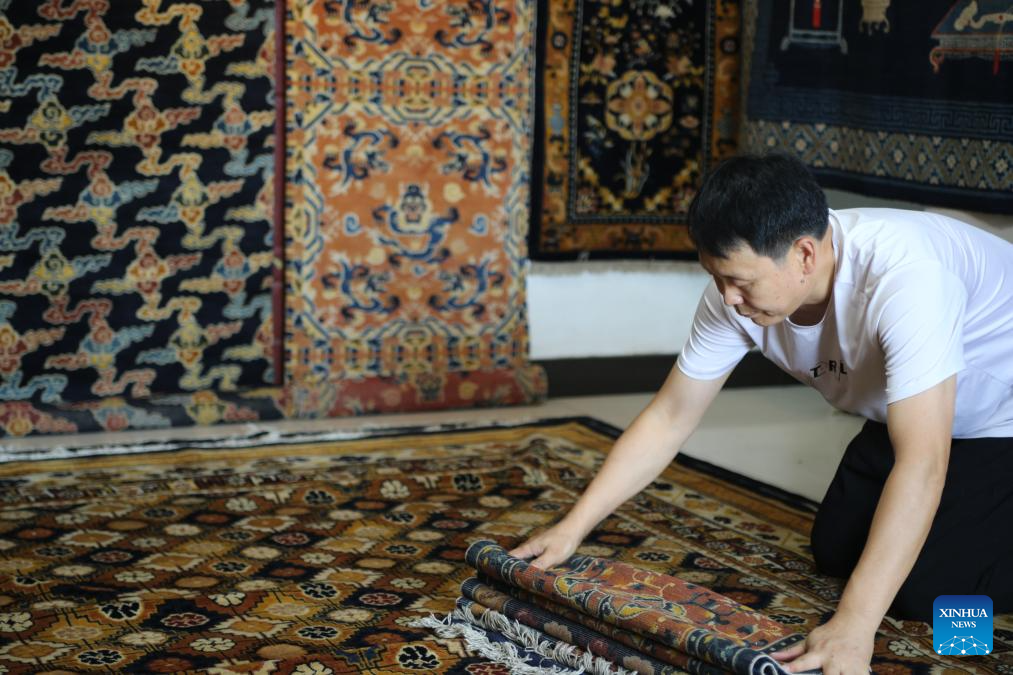
Ji Yu's husband Li Dongyang arranges palace carpets at her studio in Beijing, capital of China, June 27, 2024. Beijing palace carpet is a splendid example of China's traditional carpet weaving techniques. Known for its intricate production processes and beautiful patterns, the palace carpet represents the pinnacle of Chinese weaving artistry. The production involves four main steps: dyeing with traditional Chinese herbs, pattern design, weaving and shaping, and finally, finishing touches. As one of the "Beijing Eight Imperial Handicrafts," the art of palace carpet was designated a national intangible cultural heritage in 2008.
Ji Yu, born in 1971 in central China's Henan Province, has dedicated over 30 years to the repair and creation of traditional palace carpets. In 1995, along with her husband Li Dongyang, she moved to Beijing to specialize in restoring ancient carpets.
Over the years, the couple has insisted on traditional dyeing and weaving techniques. During the process of repairing ancient carpets, the have found and mastered many long-lost ancient techniques. Last year, Ji Yu was accepted as an apprentice of Wang Guoying, a national-level inheritor of the palace carpet tradition. (Xinhua/Zhu Weixi)
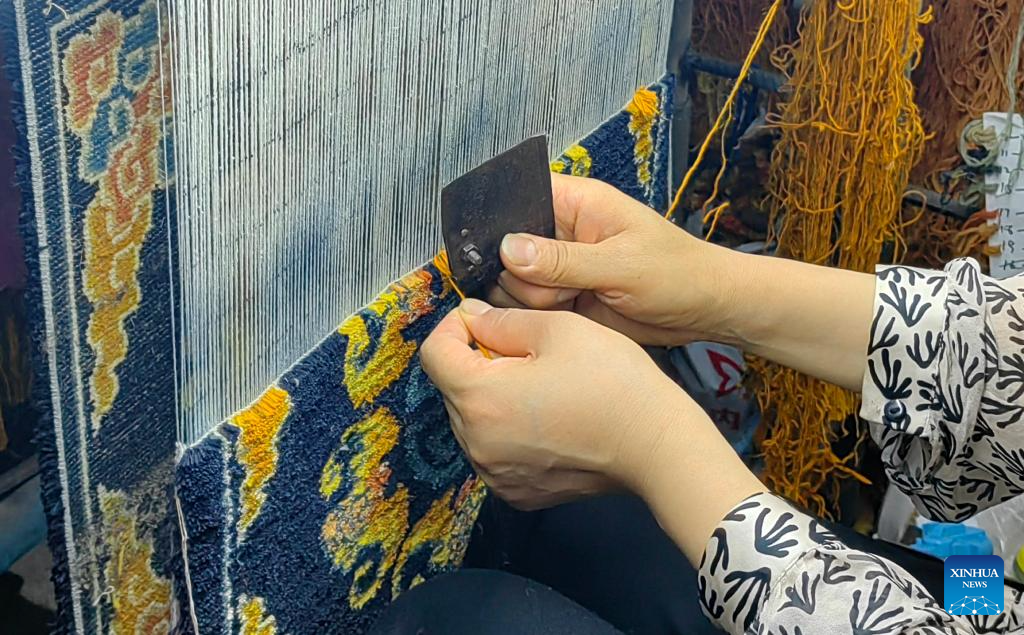
This undated photo shows Ji Yu weaving a palace carpet at her factory in central China's Henan Province. Beijing palace carpet is a splendid example of China's traditional carpet weaving techniques. Known for its intricate production processes and beautiful patterns, the palace carpet represents the pinnacle of Chinese weaving artistry. The production involves four main steps: dyeing with traditional Chinese herbs, pattern design, weaving and shaping, and finally, finishing touches. As one of the "Beijing Eight Imperial Handicrafts," the art of palace carpet was designated a national intangible cultural heritage in 2008.
Ji Yu, born in 1971 in central China's Henan Province, has dedicated over 30 years to the repair and creation of traditional palace carpets. In 1995, along with her husband Li Dongyang, she moved to Beijing to specialize in restoring ancient carpets.
Over the years, the couple has insisted on traditional dyeing and weaving techniques. During the process of repairing ancient carpets, the have found and mastered many long-lost ancient techniques. Last year, Ji Yu was accepted as an apprentice of Wang Guoying, a national-level inheritor of the palace carpet tradition. (Xinhua)

This photo taken on June 27, 2024 shows a detail of a palace carpet displayed at the studio of Ji Yu in Beijing, capital of China. Beijing palace carpet is a splendid example of China's traditional carpet weaving techniques. Known for its intricate production processes and beautiful patterns, the palace carpet represents the pinnacle of Chinese weaving artistry. The production involves four main steps: dyeing with traditional Chinese herbs, pattern design, weaving and shaping, and finally, finishing touches. As one of the "Beijing Eight Imperial Handicrafts," the art of palace carpet was designated a national intangible cultural heritage in 2008.
Ji Yu, born in 1971 in central China's Henan Province, has dedicated over 30 years to the repair and creation of traditional palace carpets. In 1995, along with her husband Li Dongyang, she moved to Beijing to specialize in restoring ancient carpets.
Over the years, the couple has insisted on traditional dyeing and weaving techniques. During the process of repairing ancient carpets, the have found and mastered many long-lost ancient techniques. Last year, Ji Yu was accepted as an apprentice of Wang Guoying, a national-level inheritor of the palace carpet tradition. (Xinhua/Tian Weiwei)
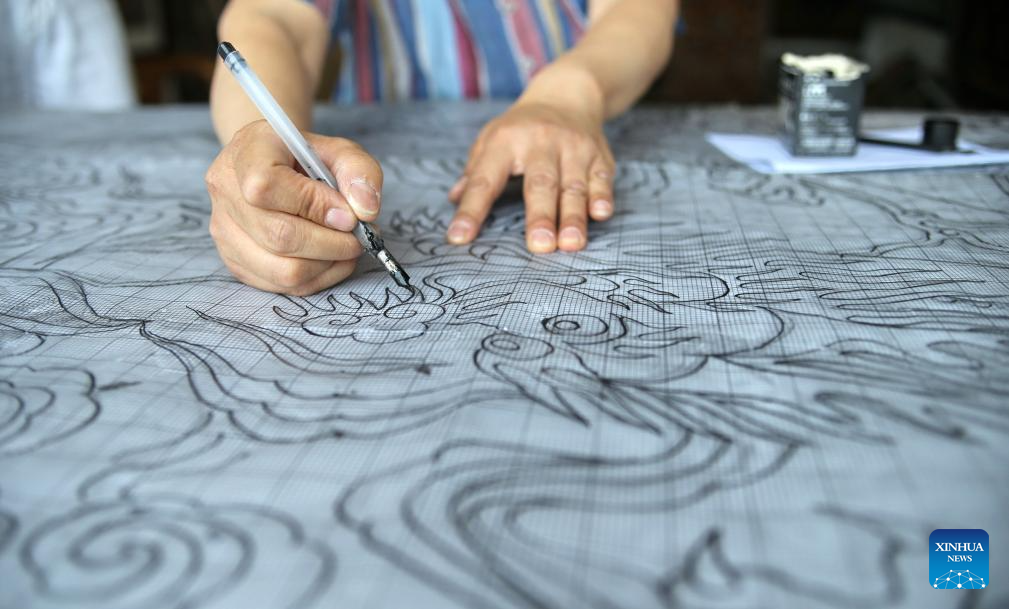
Ji Yu draws a design pattern for a palace carpet at her studio in Beijing, capital of China, June 27, 2024. Beijing palace carpet is a splendid example of China's traditional carpet weaving techniques. Known for its intricate production processes and beautiful patterns, the palace carpet represents the pinnacle of Chinese weaving artistry. The production involves four main steps: dyeing with traditional Chinese herbs, pattern design, weaving and shaping, and finally, finishing touches. As one of the "Beijing Eight Imperial Handicrafts," the art of palace carpet was designated a national intangible cultural heritage in 2008.
Ji Yu, born in 1971 in central China's Henan Province, has dedicated over 30 years to the repair and creation of traditional palace carpets. In 1995, along with her husband Li Dongyang, she moved to Beijing to specialize in restoring ancient carpets.
Over the years, the couple has insisted on traditional dyeing and weaving techniques. During the process of repairing ancient carpets, the have found and mastered many long-lost ancient techniques. Last year, Ji Yu was accepted as an apprentice of Wang Guoying, a national-level inheritor of the palace carpet tradition. (Xinhua/Zhu Weixi)
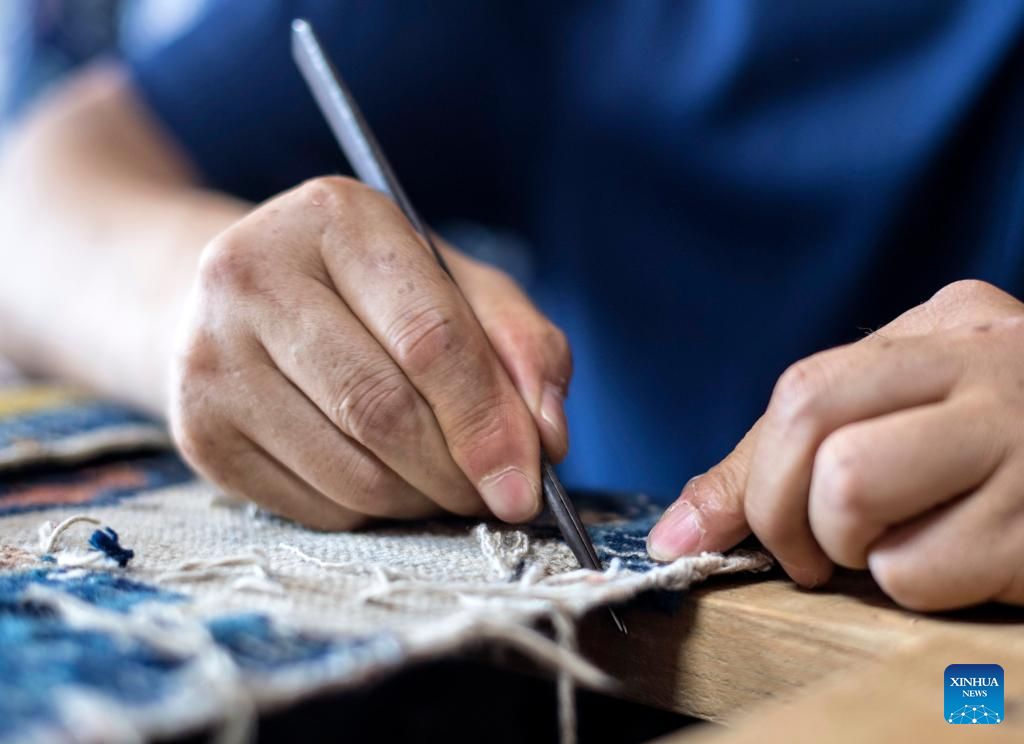
Ji Yu's husband Li Dongyang repairs a palace carpet at her studio in Beijing, capital of China, June 27, 2024. Beijing palace carpet is a splendid example of China's traditional carpet weaving techniques. Known for its intricate production processes and beautiful patterns, the palace carpet represents the pinnacle of Chinese weaving artistry. The production involves four main steps: dyeing with traditional Chinese herbs, pattern design, weaving and shaping, and finally, finishing touches. As one of the "Beijing Eight Imperial Handicrafts," the art of palace carpet was designated a national intangible cultural heritage in 2008.
Ji Yu, born in 1971 in central China's Henan Province, has dedicated over 30 years to the repair and creation of traditional palace carpets. In 1995, along with her husband Li Dongyang, she moved to Beijing to specialize in restoring ancient carpets.
Over the years, the couple has insisted on traditional dyeing and weaving techniques. During the process of repairing ancient carpets, the have found and mastered many long-lost ancient techniques. Last year, Ji Yu was accepted as an apprentice of Wang Guoying, a national-level inheritor of the palace carpet tradition. (Xinhua/Zhang Haofu)

Ji Yu's husband Li Dongyang (1st L) repairs a palace carpet while Wang Guoying (2nd L), Ji Yu (1st, R) and Ji Yu's daughter look on in Beijing, capital of China, June 27, 2024. Beijing palace carpet is a splendid example of China's traditional carpet weaving techniques. Known for its intricate production processes and beautiful patterns, the palace carpet represents the pinnacle of Chinese weaving artistry. The production involves four main steps: dyeing with traditional Chinese herbs, pattern design, weaving and shaping, and finally, finishing touches. As one of the "Beijing Eight Imperial Handicrafts," the art of palace carpet was designated a national intangible cultural heritage in 2008.
Ji Yu, born in 1971 in central China's Henan Province, has dedicated over 30 years to the repair and creation of traditional palace carpets. In 1995, along with her husband Li Dongyang, she moved to Beijing to specialize in restoring ancient carpets.
Over the years, the couple has insisted on traditional dyeing and weaving techniques. During the process of repairing ancient carpets, the have found and mastered many long-lost ancient techniques. Last year, Ji Yu was accepted as an apprentice of Wang Guoying, a national-level inheritor of the palace carpet tradition. (Xinhua/Zhang Haofu)
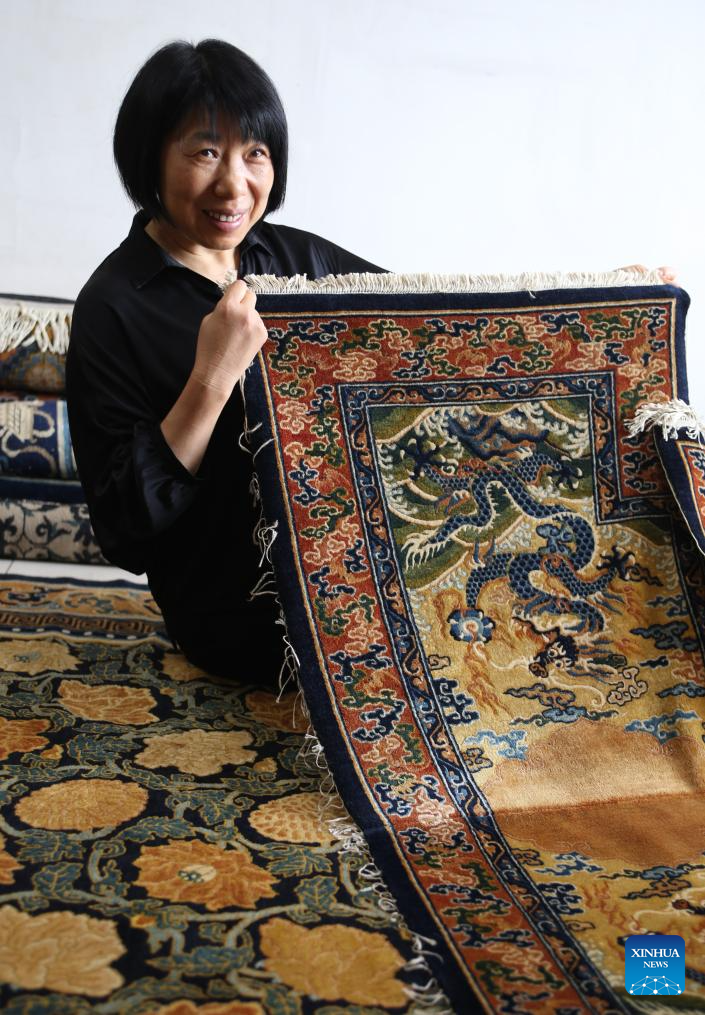
Ji Yu shows a palace carpet at her studio in Beijing, capital of China, June 27, 2024. Beijing palace carpet is a splendid example of China's traditional carpet weaving techniques. Known for its intricate production processes and beautiful patterns, the palace carpet represents the pinnacle of Chinese weaving artistry. The production involves four main steps: dyeing with traditional Chinese herbs, pattern design, weaving and shaping, and finally, finishing touches. As one of the "Beijing Eight Imperial Handicrafts," the art of palace carpet was designated a national intangible cultural heritage in 2008.
Ji Yu, born in 1971 in central China's Henan Province, has dedicated over 30 years to the repair and creation of traditional palace carpets. In 1995, along with her husband Li Dongyang, she moved to Beijing to specialize in restoring ancient carpets.
Over the years, the couple has insisted on traditional dyeing and weaving techniques. During the process of repairing ancient carpets, the have found and mastered many long-lost ancient techniques. Last year, Ji Yu was accepted as an apprentice of Wang Guoying, a national-level inheritor of the palace carpet tradition. (Xinhua/Zhu Weixi)



